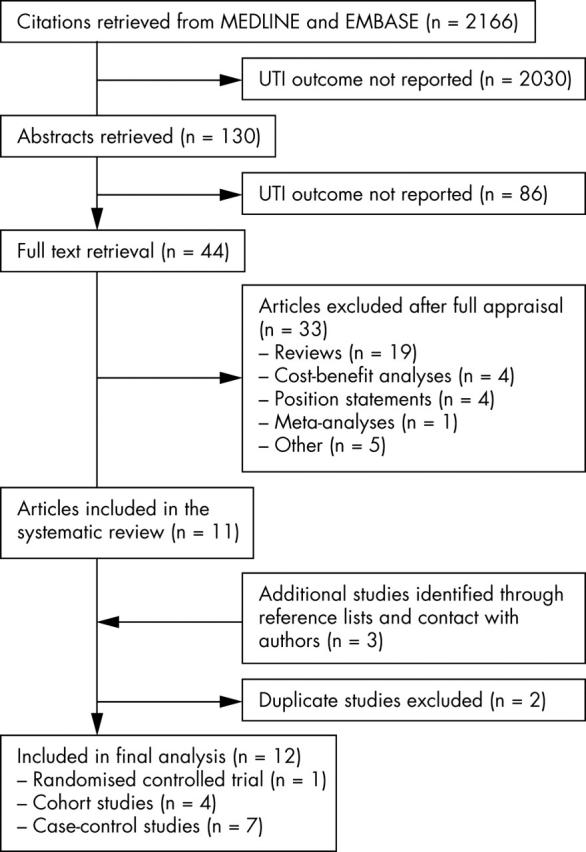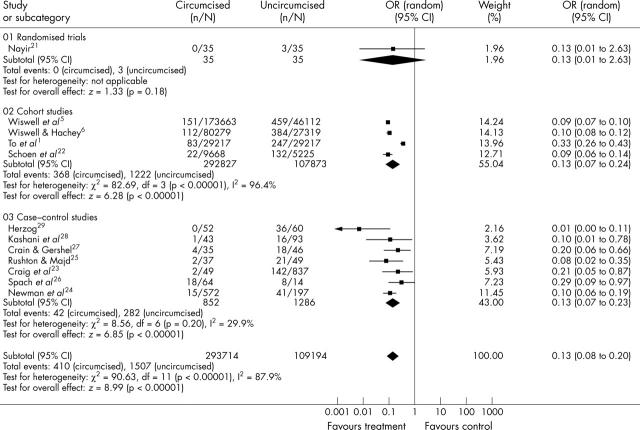Abstract
Objective: To undertake a meta-analysis of published data on the effect of circumcision on the risk of urinary tract infection (UTI) in boys.
Data sources: Randomised controlled trials and observational studies comparing the frequency of UTI in circumcised and uncircumcised boys were identified from the Cochrane controlled trials register, MEDLINE, EMBASE, reference lists of retrieved articles, and contact with known investigators.
Methods: Two of the authors independently assessed study quality using the guidelines provided by the MOOSE statement for quality of observational studies. A random effects model was used to estimate a summary odds ratio (OR) with 95% confidence intervals (CI).
Results: Data on 402 908 children were identified from 12 studies (one randomised controlled trial, four cohort studies, and seven case–control studies). Circumcision was associated with a significantly reduced risk of UTI (OR = 0.13; 95% CI, 0.08 to 0.20; p<0.001) with the same odds ratio (0.13) for all three types of study design.
Conclusions: Circumcision reduces the risk of UTI. Given a risk in normal boys of about 1%, the number-needed-to-treat to prevent one UTI is 111. In boys with recurrent UTI or high grade vesicoureteric reflux, the risk of UTI recurrence is 10% and 30% and the numbers-needed-to-treat are 11 and 4, respectively. Haemorrhage and infection are the commonest complications of circumcision, occurring at rate of about 2%. Assuming equal utility of benefits and harms, net clinical benefit is likely only in boys at high risk of UTI.
Full Text
The Full Text of this article is available as a PDF (93.1 KB).
Figure 1.

Flow chart outlining the study selection process for the effect of circumcision on urinary tract infection.
Figure 2.
Meta-analysis of studies examining the effect of circumcision on urinary tract infection in male subjects.
Selected References
These references are in PubMed. This may not be the complete list of references from this article.
- Amato D., Garduño-Espinosa J. Circuncisión en el niño recién nacido y el riesgo de presentar infección de vías urinarias durante el primer año de vida. Un meta-análisis. Bol Med Hosp Infant Mex. 1992 Oct;49(10):652–658. [PubMed] [Google Scholar]
- Begg C., Cho M., Eastwood S., Horton R., Moher D., Olkin I., Pitkin R., Rennie D., Schulz K. F., Simel D. Improving the quality of reporting of randomized controlled trials. The CONSORT statement. JAMA. 1996 Aug 28;276(8):637–639. doi: 10.1001/jama.276.8.637. [DOI] [PubMed] [Google Scholar]
- Castellsagué Xavier, Bosch F. Xavier, Muñoz Nubia, Meijer Chris J. L. M., Shah Keerti V., de Sanjose Silvia, Eluf-Neto José, Ngelangel Corazon A., Chichareon Saibua, Smith Jennifer S. Male circumcision, penile human papillomavirus infection, and cervical cancer in female partners. N Engl J Med. 2002 Apr 11;346(15):1105–1112. doi: 10.1056/NEJMoa011688. [DOI] [PubMed] [Google Scholar]
- Cook L. S., Koutsky L. A., Holmes K. K. Circumcision and sexually transmitted diseases. Am J Public Health. 1994 Feb;84(2):197–201. doi: 10.2105/ajph.84.2.197. [DOI] [PMC free article] [PubMed] [Google Scholar]
- Craig J. C., Knight J. F., Sureshkumar P., Mantz E., Roy L. P. Effect of circumcision on incidence of urinary tract infection in preschool boys. J Pediatr. 1996 Jan;128(1):23–27. doi: 10.1016/s0022-3476(96)70423-7. [DOI] [PubMed] [Google Scholar]
- Crain E. F., Gershel J. C. Urinary tract infections in febrile infants younger than 8 weeks of age. Pediatrics. 1990 Sep;86(3):363–367. [PubMed] [Google Scholar]
- Dewan P. A., Tieu H. C., Chieng B. S. Phimosis: is circumcision necessary? J Paediatr Child Health. 1996 Aug;32(4):285–289. doi: 10.1111/j.1440-1754.1996.tb02554.x. [DOI] [PubMed] [Google Scholar]
- Griffiths D. M., Atwell J. D., Freeman N. V. A prospective survey of the indications and morbidity of circumcision in children. Eur Urol. 1985;11(3):184–187. doi: 10.1159/000472487. [DOI] [PubMed] [Google Scholar]
- Harkavy K. L. The circumcision debate. Pediatrics. 1987 Apr;79(4):649–650. [PubMed] [Google Scholar]
- Hellström A., Hanson E., Hansson S., Hjälmås K., Jodal U. Association between urinary symptoms at 7 years old and previous urinary tract infection. Arch Dis Child. 1991 Feb;66(2):232–234. doi: 10.1136/adc.66.2.232. [DOI] [PMC free article] [PubMed] [Google Scholar]
- Herzog L. W. Urinary tract infections and circumcision. A case-control study. Am J Dis Child. 1989 Mar;143(3):348–350. doi: 10.1001/archpedi.1989.02150150106026. [DOI] [PubMed] [Google Scholar]
- Higgins Julian P. T., Thompson Simon G., Deeks Jonathan J., Altman Douglas G. Measuring inconsistency in meta-analyses. BMJ. 2003 Sep 6;327(7414):557–560. doi: 10.1136/bmj.327.7414.557. [DOI] [PMC free article] [PubMed] [Google Scholar]
- Kaplan G. W. Complications of circumcision. Urol Clin North Am. 1983 Aug;10(3):543–549. [PubMed] [Google Scholar]
- Nayir A. Circumcision for the prevention of significant bacteriuria in boys. Pediatr Nephrol. 2001 Dec;16(12):1129–1134. doi: 10.1007/s004670100044. [DOI] [PubMed] [Google Scholar]
- Newman Thomas B., Bernzweig Jane A., Takayama John I., Finch Stacia A., Wasserman Richard C., Pantell Robert H. Urine testing and urinary tract infections in febrile infants seen in office settings: the Pediatric Research in Office Settings' Febrile Infant Study. Arch Pediatr Adolesc Med. 2002 Jan;156(1):44–54. doi: 10.1001/archpedi.156.1.44. [DOI] [PubMed] [Google Scholar]
- Panaretto K., Craig J., Knight J., Howman-Giles R., Sureshkumar P., Roy L. Risk factors for recurrent urinary tract infection in preschool children. J Paediatr Child Health. 1999 Oct;35(5):454–459. doi: 10.1046/j.1440-1754.1999.355417.x. [DOI] [PubMed] [Google Scholar]
- Rushton H. G., Majd M. Pyelonephritis in male infants: how important is the foreskin? J Urol. 1992 Aug;148(2 Pt 2):733–738. doi: 10.1016/s0022-5347(17)36706-x. [DOI] [PubMed] [Google Scholar]
- Schoen E. J., Colby C. J., Ray G. T. Newborn circumcision decreases incidence and costs of urinary tract infections during the first year of life. Pediatrics. 2000 Apr;105(4 Pt 1):789–793. doi: 10.1542/peds.105.4.789. [DOI] [PubMed] [Google Scholar]
- Schoen E. J. The relationship between circumcision and cancer of the penis. CA Cancer J Clin. 1991 Sep-Oct;41(5):306–309. doi: 10.3322/canjclin.41.5.306. [DOI] [PubMed] [Google Scholar]
- Shaneyfelt T. M., Mayo-Smith M. F., Rothwangl J. Are guidelines following guidelines? The methodological quality of clinical practice guidelines in the peer-reviewed medical literature. JAMA. 1999 May 26;281(20):1900–1905. doi: 10.1001/jama.281.20.1900. [DOI] [PubMed] [Google Scholar]
- Spach D. H., Stapleton A. E., Stamm W. E. Lack of circumcision increases the risk of urinary tract infection in young men. JAMA. 1992 Feb 5;267(5):679–681. [PubMed] [Google Scholar]
- Stroup D. F., Berlin J. A., Morton S. C., Olkin I., Williamson G. D., Rennie D., Moher D., Becker B. J., Sipe T. A., Thacker S. B. Meta-analysis of observational studies in epidemiology: a proposal for reporting. Meta-analysis Of Observational Studies in Epidemiology (MOOSE) group. JAMA. 2000 Apr 19;283(15):2008–2012. doi: 10.1001/jama.283.15.2008. [DOI] [PubMed] [Google Scholar]
- To T., Agha M., Dick P. T., Feldman W. Cohort study on circumcision of newborn boys and subsequent risk of urinary-tract infection. Lancet. 1998 Dec 5;352(9143):1813–1816. doi: 10.1016/S0140-6736(98)02392-7. [DOI] [PubMed] [Google Scholar]
- Williams N., Kapila L. Complications of circumcision. Br J Surg. 1993 Oct;80(10):1231–1236. doi: 10.1002/bjs.1800801005. [DOI] [PubMed] [Google Scholar]
- Winberg J., Andersen H. J., Bergström T., Jacobsson B., Larson H., Lincoln K. Epidemiology of symptomatic urinary tract infection in childhood. Acta Paediatr Scand Suppl. 1974;(252):1–20. doi: 10.1111/j.1651-2227.1974.tb05718.x. [DOI] [PubMed] [Google Scholar]
- Wiswell T. E., Enzenauer R. W., Holton M. E., Cornish J. D., Hankins C. T. Declining frequency of circumcision: implications for changes in the absolute incidence and male to female sex ratio of urinary tract infections in early infancy. Pediatrics. 1987 Mar;79(3):338–342. [PubMed] [Google Scholar]
- Wiswell T. E., Hachey W. E. Urinary tract infections and the uncircumcised state: an update. Clin Pediatr (Phila) 1993 Mar;32(3):130–134. doi: 10.1177/000992289303200301. [DOI] [PubMed] [Google Scholar]
- Wiswell T. E., Miller G. M., Gelston H. M., Jr, Jones S. K., Clemmings A. F. Effect of circumcision status on periurethral bacterial flora during the first year of life. J Pediatr. 1988 Sep;113(3):442–446. doi: 10.1016/s0022-3476(88)80625-5. [DOI] [PubMed] [Google Scholar]



